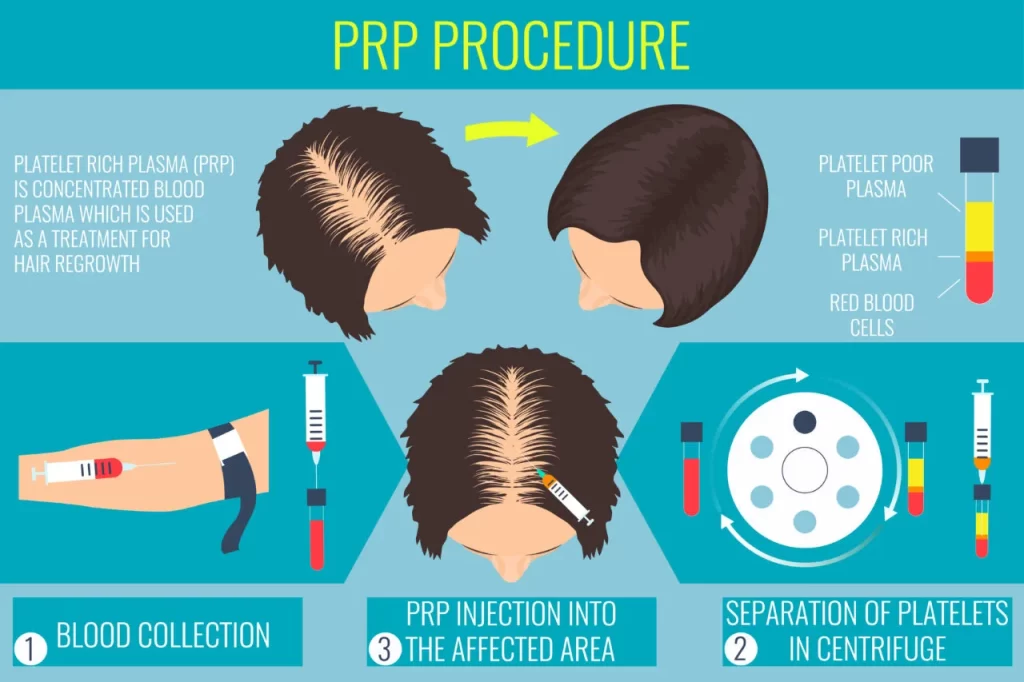
Sick of hair loss tricks that sound amazing but don’t work? Let’s talk about Platelet-Rich Plasma (PRP) treatment—an effective option that is getting a lot attention by the masses.
Here we will try to find out, what is real or if there is an unnecessary hype created around this procedure by checking the facts & science backed studies to says about how safe and effective it really is.
With this treatment, just be ready to say goodbye to thinning hair issues and embrace the head with dense & thicker hair? Let’s figure out the facts together!
Does PRP Actually Help Hair Grow?
Okay, so what’s the deal with PRP working for hair loss? Studies have been checking it out, and here’s what they’ve found. One from 2019 showed that folks who got three PRP shots, spaced a month apart, saw their hair get thicker compared to people who got fake shots. Another study in 2020 said after six monthly sessions, people had more hair—and stronger strands too. Pretty promising, right?
But here’s the catch: these studies were small, and they didn’t stick around long enough to see what happens years later. So, while it looks good so far, we need bigger, longer studies to say, “Yep, this is a sure thing!”
Is PRP Safe?
Good news—PRP is pretty chill when it comes to safety. Since it’s made from your own blood, there’s almost no chance of allergic reactions or big problems. You might get a little redness or bruising where the needle goes in, but that usually fades fast—like a couple of days. Just make sure you talk to a pro beforehand to double-check it’s cool for you.
How PRP for Hair Loss Got Started?
PRP isn’t some shiny new idea—it’s been around since the 1970s! Doctors first used it to help heal bones and tissues in surgeries, and even dentists jumped on board to speed up recovery after tooth stuff. Why? Because PRP is packed with growth factors—little helpers that fix and regrow stuff in your body.
Fast forward to the late ‘90s, and people started wondering, “Hey, could this help hair too?” A 2006 study said yes, showing it worked for guys with bald spots.
That sparked a wave of excitement, and now it’s a go-to for folks wanting a non-surgical hair fix. They draw your blood, spin it to get the good stuff, and inject it into your scalp—simple, but kinda genius!
The big perk? It’s less intense than a hair transplant. But not everyone agrees on how well it works—some studies say it’s awesome, others say it’s meh. Plus, every clinic does it a bit differently, so it’s hard to pin down. More research will help clear things up!
What Studies Say About PRP Safety?
Scientists have been poking around to see if PRP is risky, and so far, it’s looking safe. A study in the Journal of Cosmetic Dermatology checked 23 people getting PRP for common hair loss—no one had any big issues. Another one in the Aesthetic Surgery Journal with 20 folks said the same—no major hiccups.
A bigger review of nine studies and 460 people found no serious problems either. Even a three-year look-back at patients showed no long-term trouble. Some folks felt a headache or swelling for a bit, but nothing wild. Bottom line? When a trained pro does it, PRP seems like a low-risk move. Still, talk it over with your doctor to be sure.
Does PRP Really Work? Here’s the Data
So, does PRP actually grow hair? The results are a mixed bag. One study in the Journal of Cutaneous and Aesthetic Surgery said four sessions bumped up hair thickness after six months. But another in Dermatologic Surgery found no difference compared to a placebo. A Harvard review of 11 studies saw a slight trend toward thicker hair, but it wasn’t a slam dunk.
Some folks think the boost might come from extras like microneedling or meds like minoxidil, not just PRP. And we don’t have long-term data yet to know if the hair sticks around. It might help, but it’s not a quick fix—you’ll likely need a few rounds. Chat with a pro to see if it’s worth a shot for you!
Busting Myths About PRP for Hair Loss
With all the hype, there’s some nonsense floating around about PRP. Let’s clear it up:
- Myth #1: It Hurts Like Crazy
Nope! They numb your scalp first, so it’s more like a little poke than a horror show. Easy peasy. - Myth #2: Hair Grows Back Overnight
Sorry, no instant magic here. It takes a few months—think 3 to 6—to see thicker hair. It’s a slow build, but worth the wait for many. - Myth #3: Anyone Can Do It
Big no! Only trained pros should handle this. DIY or sketchy spots could mess things up—stick with someone legit. - Myth #4: You’re Stuck Doing It Forever
Not true. Once your hair’s looking good, you can switch to occasional touch-ups—not a lifetime commitment. - Myth #5: It Works for Everyone
It’s awesome for some, but not a cure-all. How bad your hair loss is, your health, and even your genes play a role. A doc can tell you if it’s your thing.
Let’s keep it real—PRP’s got potential, but it’s not perfect for everyone. Talk to a dermatologist to get the full scoop before jumping in!



Leave a Reply